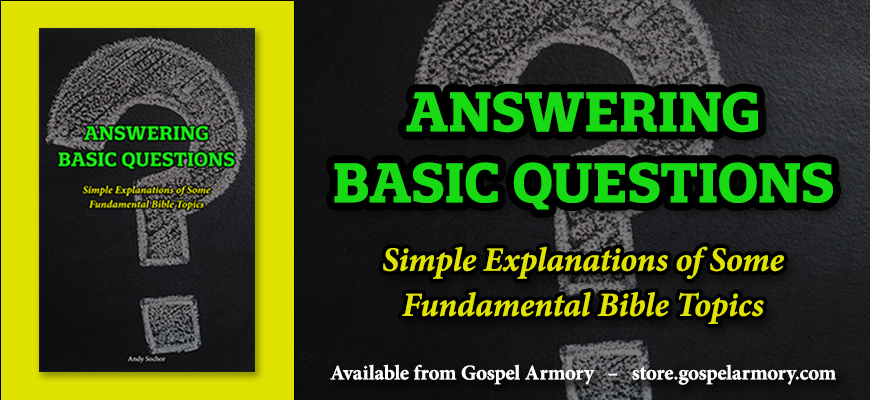
“In the beginning was the Word, and the Word was with God, and the Word was God” (John 1:1).
“And the Word became flesh, and dwelt among us, and we saw His glory, glory as of the only begotten from the Father, full of grace and truth” (John 1:14).
The gospel of John was written to teach people about Jesus. The first chapter introduces Jesus to us. We learn of Him through the various words and phrases used to describe the Lord, some of which are found in the verses above. The opening chapter of John is a good place to go to learn, be reminded, or teach others about Jesus. Let us briefly consider some of the ways in which Jesus is described in these verses.
Jesus Is the Word
“In the beginning was the Word…” (John 1:1).
Several points are implied by the word, Word. First, the Word is an announcement – revealing what otherwise would not have been known. Jesus is the spokesman for the Father during these last days (Hebrews 1:2). Jesus said, “Therefore the things I speak, I speak just as the Father has told Me” (John 12:50). Second, the Word includes doctrine – teaching that we must obey. All authority was given to Jesus; therefore, His disciples are to observe His commandments (Matthew 28:18-20). Third, the Word indicates a direction – a way that we should go. Jesus told His disciples, “I am the way… no one comes to the Father but through Me” (John 14:6).
Jesus is not whoever we want Him to be. As the Word, He is a divine being with objective standards and expectations of us. We must conform our lives to His will, rather than try to conform Him to our will.
Jesus Is Eternal
“In the beginning was the Word… He was in the beginning with God” (John 1:1-2).
Though Jesus was “born of a woman” at a particular time – “when the fulness of the time came” (Galatians 4:4) – the Spirit of Christ existed long before that. John the Baptist was born before Jesus (Luke 1:35-36), yet he said of Christ, “After me comes a Man who has a higher rank than I, for He existed before me” (John 1:30). Jesus said elsewhere, “Before Abraham was born, I am” (John 8:58).
Jesus was “in the beginning with God” (John 1:2). His existence is eternal, “having neither beginning of days nor end of life” (Hebrews 7:3). He was not a created being, but existed “in the beginning” – the “time” before Creation.
Jesus Is God
“The Word was God” (John 1:1).
Jesus was not just a good man, wise teacher, or even a prophet. Jesus was God in the flesh (Matthew 1:23). Isaiah prophesied: “For a child will be born to us, a son will be given to us; and the government will rest on His shoulders; and His name will be called Wonderful Counselor, Mighty God, Eternal Father, Prince of Peace” (Isaiah 9:6).
Jesus “was with God, and…was God” (John 1:1). He was, and is, one of three persons of the Godhead – the Father (Titus 1:4), the Son (Titus 2:13), and the Holy Spirit (Acts 5:3-4). Jesus was equal with the Father (John 5:18; 10:30) and, while on earth, rightfully accepted worship (Matthew 28:9, 17; Luke 24:52) which is to be directed only to God (Revelation 22:8-9). Jesus was not just a man, but is God.
Jesus Is the Giver of Life
“All things came into being through Him, and apart from Him nothing came into being that has come into being. In Him was life…” (John 1:3-4).
John first described Jesus as being the giver of physical life. He was instrumental in Creation (John 1:3). Paul told the brethren in Colosse that Jesus is both the Creator and Sustainer of life. “For by Him all things were created…all things have been created through Him and for Him. He is before all things, and in Him all things hold together” (Colossians 1:16-17).
However, Jesus is not just the giver of physical life, but also of spiritual life. He provides the hope of eternal life for those who are “born again” (John 3:3-5, 16). Paul told the saints in Rome, “For the wages of sin is death, but the free gift of God is eternal life in Christ Jesus our Lord” (Romans 6:23). Through Jesus, we have the hope of salvation (1 Thessalonians 5:9).
Jesus Is the Light
“In Him was life, and the life was the Light of men. The Light shines in the darkness, and the darkness did not comprehend it” (John 1:4-5).
Elsewhere, Jesus said, “I am the Light of the world; he who follows Me will not walk in the darkness, but will have the Light of life” (John 8:12). The idea of Jesus being the Light is connected to Him being the Word. The psalmist wrote, “Your word is a lamp to my feet and a light to my path” (Psalm 119:105). As the Light, Jesus provides the world with revelation, knowledge, and direction. [We noted these in the first section about Jesus as the Word. He announced what was being revealed, delivered His doctrine which we are to know, and directed us in the path we should go.]
Jesus Became Flesh
“And the Word became flesh, and dwelt among us…” (John 1:14).
Jesus becoming flesh was part of God’s plan from the beginning. After sin was introduced into the world, God cursed the serpent and revealed a prophecy about the coming of Christ: “And I will put enmity between you and the woman, and between your seed and her seed; he shall bruise you on the head, and you shall bruise him on the heel” (Genesis 3:15). Jesus “partook” of “flesh and blood” so that He could deliver this crushing blow to Satan (Hebrews 2:14). Since “it is impossible for the blood of bulls and goats to take away sins,” God prepared “a body” for Jesus so that He could make a suitable atonement sacrifice (Hebrews 10:4-5).
However, it is important to note that Jesus “became flesh” without surrendering His deity. When the inspired apostle said Jesus “was God” (John 1:1), he did not mean that Jesus used to be God but was no longer God. “Jesus Christ is the same yesterday and today and forever” (Hebrews 13:8). Paul wrote, “For in Him all the fullness of Deity dwells in bodily form” (Colossians 2:9). When Jesus “became flesh,” He did not cease to be who He was (God). Instead, His divine spirit inhabited a flesh and blood body.
Jesus Explained the Father
“No one has seen God at any time; the only begotten God who is in the bosom of the Father, He has explained Him” (John 1:18).
In Jesus, the Son of God, we see the Father. Jesus made this clear in a conversation He had with Philip. “Philip said to Him, ‘Lord, show us the Father, and it is enough for us.’ Jesus said to him, ‘Have I been so long with you, and yet you have not come to know Me, Philip? He who has seen Me has seen the Father; how can you say, “Show us the Father”?’” (John 14:8-9). One can know the Father by examining the works and words of Christ.
This reminds us of Jesus’ role in revelation. His works and words show us the Father. “Therefore Jesus answered and was saying to them, ‘Truly, truly, I say to you, the Son can do nothing of Himself, unless it is something He sees the Father doing; for whatever the Father does, these things the Son also does in like manner’” (John 5:19). “So Jesus said, ‘When you lift up the Son of Man, then you will know that I am He, and I do nothing of My own initiative, but I speak these things as the Father taught Me’” (John 8:28). All of this also shows us the unity between the Father and the Son. Jesus said, “I and the Father are one” (John 10:30). We cannot accept one and not the other (Luke 10:16).
Jesus Is the Lamb of God
“The next day he saw Jesus coming to him and said, ‘Behold, the Lamb of God who takes away the sin of the world!’” (John 1:29).
This was Jesus’ mission – to make forgiveness available to all men (Luke 24:47; Acts 10:43). He was called a Lamb because He would be sacrificed, just as was done with lambs under the Old Testament system (Exodus 12:3-7; Deuteronomy 16:1-2; 1 Corinthians 5:7). Jesus said, “‘And I, if I am lifted up from the earth, will draw all men to Myself.’ But He was saying this to indicate the kind of death by which He was to die” (John 12:32-33). He came to earth in order to “give His life a ransom for many” (Matthew 20:28). Forgiveness is available “through His blood” which He shed on the cross (Ephesians 1:7).
Jesus’ death on the cross was not for His own sins – He had none (Isaiah 53:9; 1 Peter 2:22). Instead of dying for His sins, He made atonement for our sins (Romans 5:8-11). However, if we want to be saved from our sins, we must take advantage of His sacrifice. That means obeying Him (Hebrews 5:9) – this includes baptism in which our sins are washed away (Acts 2:38; 22:16) – and remaining faithful until death (Revelation 2:10).
Conclusion
The first chapter of John is a great place to go to be reminded about Jesus – who He is and what He came to do. It is also a good place to go to teach people who are not familiar with Jesus. Let us remember the lessons contained in this chapter so that we might faithfully follow Him and try to bring others to Him as well.










